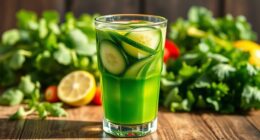Grapefruit juice has about 25 grams of carbohydrates in an 8 fl oz serving. Most of these carbs come from natural sugars, accounting for roughly 21 grams of the total. It's a refreshing option that provides quick energy, making it ideal for active individuals. However, it's low in fiber, so you'll need additional sources to meet your daily needs. If you're curious about how grapefruit juice fits into your diet, there's more you might want to explore.
Key Takeaways
- An 8 fl oz serving of grapefruit juice contains approximately 25 grams of carbohydrates.
- Out of the 25 grams, about 21 grams are natural sugars.
- Grapefruit juice is low in fat, contributing 0% fat content.
- It has only 1 gram of fiber per serving, making it low in fiber.
- Carbohydrates in grapefruit juice provide quick energy, appealing for active individuals.

Have you ever wondered how many carbs are in grapefruit juice? If you're looking for a refreshing drink that packs a punch, grapefruit juice might be on your radar. In an 8 fl oz serving, you'll find approximately 25 grams of carbohydrates, which primarily come from natural sugars. It's interesting to note that about 21 grams of that's sugar. This makes grapefruit juice a good source of quick energy, especially if you're active and need a little boost.
When you're tracking your carb intake, it's essential to consider how these carbohydrates fit into your daily diet. With around 100 calories per serving, carbohydrates make up about 96% of the total caloric content in grapefruit juice. Since it's low in fat—0% fat, to be exact—grapefruit juice becomes an appealing option for those watching their fat intake.
However, you should keep in mind that it isn't a good source of protein, as it contains negligible amounts. If you're looking for a well-rounded beverage, you might need to complement it with something higher in protein.
Fiber content is another factor to consider. Grapefruit juice has only 1 gram of fiber per 8 fl oz serving. While fiber is crucial for digestive health, the low fiber content in grapefruit juice means it won't significantly contribute to your daily fiber needs. The Daily Value for fiber is about 28 grams, so you'll need to get fiber from other sources in your diet to meet those requirements.
It's essential to balance your carb intake with your overall dietary goals. If you're following a specific diet plan, like a low-carb or ketogenic diet, you might want to limit how much grapefruit juice you consume. Depending on your needs, you can still enjoy it in moderation, especially if you appreciate the tangy flavor. Just remember to account for those carbs when you plan your meals.
Frequently Asked Questions
Can You Drink Grapefruit Juice on Keto?
You might want to think twice before drinking grapefruit juice on a keto diet. Its high carbohydrate content can throw you out of ketosis, making it hard to achieve your goals.
While it's packed with nutrients, the sugar can hinder your progress. Instead, consider opting for lower-carb alternatives like lemon or lime juice.
Always check with a healthcare professional to ensure your dietary choices align with your health goals and keto lifestyle.
Is Grapefruit Juice High in Carbs?
Imagine you're on a treasure hunt, but instead of gold, you find a bounty of carbs in grapefruit juice.
Yes, grapefruit juice does have a notable carbohydrate content, primarily from natural sugars. In an 8 fl oz serving, you're looking at around 25 grams of carbs.
While it's low in fat and calories, the carbohydrate count might surprise you if you're watching your intake.
How Many Carbs Are in an 8 Oz Glass of Grapefruit Juice?
If you're curious about the carbohydrate content in an 8 oz glass of grapefruit juice, you'll find it contains 25 grams of total carbohydrates.
Most of these carbs come from natural sugars, adding up to 21 grams of sugar per serving.
With no fat, grapefruit juice is primarily made of carbs, which account for about 96% of its total calories.
Does Grapefruit Juice Raise Your Sugar?
Did you know that grapefruit juice has about 21 grams of sugar in an 8-ounce serving?
If you're watching your blood sugar levels, it's important to consider that grapefruit juice can raise your sugar levels.
Though it has a lower glycemic index than some other juices, the natural sugars can still impact your body.
Moderation is key, so enjoy it responsibly to avoid any sudden spikes in your blood sugar.
Conclusion
In the world of fruits, grapefruit juice stands as a bright sun, radiating flavor and health benefits. With just about 9 grams of carbs per 8-ounce serving, it offers a refreshing choice without overwhelming your diet. Just like a sunrise, it can awaken your senses and kickstart your day. So, when you pour that glass, remember you’re not just sipping juice; you’re embracing a burst of vitality that can illuminate your wellness journey. Additionally, grapefruit juice is known for its potential to boost metabolism and support weight management, making it a perfect companion for health-conscious individuals. On the other hand, if you’re curious about how many carbs in tomato juice, you’ll find that it offers a similar low-carb option, typically around 7 grams per 8-ounce serving. Each juice, whether grapefruit or tomato, brings its unique set of nutrients, enriching your diet and adding variety to your daily wellness routine.
Cindy thoroughly researches juicing trends, techniques, and recipes to provide readers with practical advice and inspiration. Her writing style is accessible, engaging, and designed to make complex concepts easy to understand. Cindy’s dedication to promoting the advantages of juicing shines through her work, empowering readers to make positive changes in their lives through the simple act of juicing.











